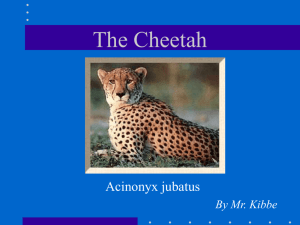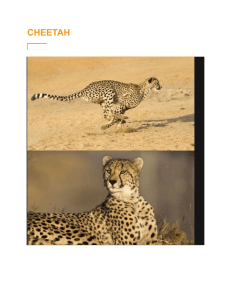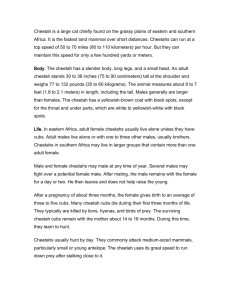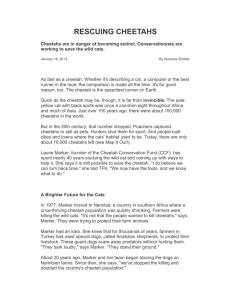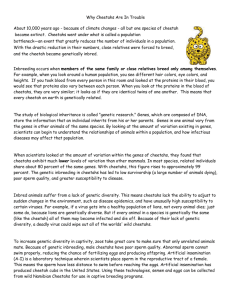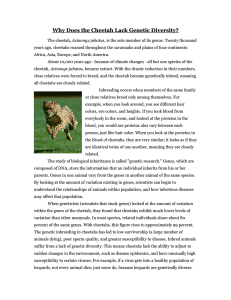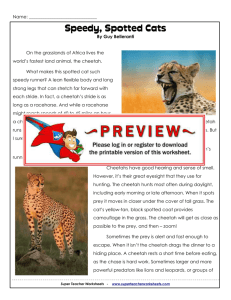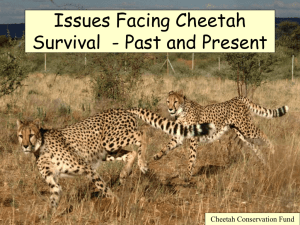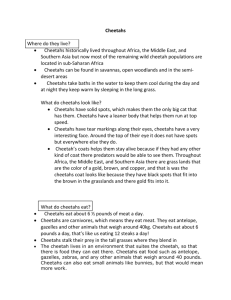Cheetah - Denver Zoo
advertisement
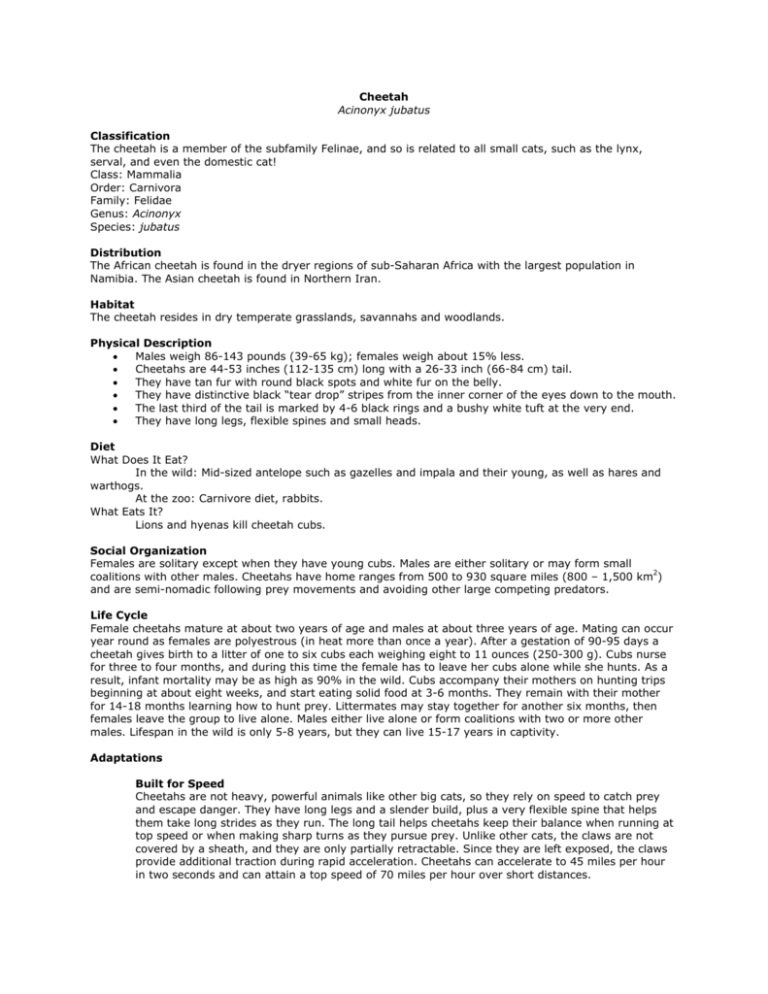
Cheetah Acinonyx jubatus Classification The cheetah is a member of the subfamily Felinae, and so is related to all small cats, such as the lynx, serval, and even the domestic cat! Class: Mammalia Order: Carnivora Family: Felidae Genus: Acinonyx Species: jubatus Distribution The African cheetah is found in the dryer regions of sub-Saharan Africa with the largest population in Namibia. The Asian cheetah is found in Northern Iran. Habitat The cheetah resides in dry temperate grasslands, savannahs and woodlands. Physical Description • Males weigh 86-143 pounds (39-65 kg); females weigh about 15% less. • Cheetahs are 44-53 inches (112-135 cm) long with a 26-33 inch (66-84 cm) tail. • They have tan fur with round black spots and white fur on the belly. • They have distinctive black “tear drop” stripes from the inner corner of the eyes down to the mouth. • The last third of the tail is marked by 4-6 black rings and a bushy white tuft at the very end. • They have long legs, flexible spines and small heads. Diet What Does It Eat? In the wild: Mid-sized antelope such as gazelles and impala and their young, as well as hares and warthogs. At the zoo: Carnivore diet, rabbits. What Eats It? Lions and hyenas kill cheetah cubs. Social Organization Females are solitary except when they have young cubs. Males are either solitary or may form small coalitions with other males. Cheetahs have home ranges from 500 to 930 square miles (800 – 1,500 km2) and are semi-nomadic following prey movements and avoiding other large competing predators. Life Cycle Female cheetahs mature at about two years of age and males at about three years of age. Mating can occur year round as females are polyestrous (in heat more than once a year). After a gestation of 90-95 days a cheetah gives birth to a litter of one to six cubs each weighing eight to 11 ounces (250-300 g). Cubs nurse for three to four months, and during this time the female has to leave her cubs alone while she hunts. As a result, infant mortality may be as high as 90% in the wild. Cubs accompany their mothers on hunting trips beginning at about eight weeks, and start eating solid food at 3-6 months. They remain with their mother for 14-18 months learning how to hunt prey. Littermates may stay together for another six months, then females leave the group to live alone. Males either live alone or form coalitions with two or more other males. Lifespan in the wild is only 5-8 years, but they can live 15-17 years in captivity. Adaptations Built for Speed Cheetahs are not heavy, powerful animals like other big cats, so they rely on speed to catch prey and escape danger. They have long legs and a slender build, plus a very flexible spine that helps them take long strides as they run. The long tail helps cheetahs keep their balance when running at top speed or when making sharp turns as they pursue prey. Unlike other cats, the claws are not covered by a sheath, and they are only partially retractable. Since they are left exposed, the claws provide additional traction during rapid acceleration. Cheetahs can accelerate to 45 miles per hour in two seconds and can attain a top speed of 70 miles per hour over short distances. Stalk and Sprint The cheetah’s tan coloration and black spots helps it blend into the grassland habitat. They stalk their prey to within about 300 feet and then sprint to pounce on the prey animal. Although cheetahs are very fast, they do not have great endurance. Even though the average high-speed chase only last 20-60 seconds, cheetahs often must rest and catch their breath after capturing prey before they can begin eating. Cheetahs eat their fill at one time but do not return to the kill later so they need to hunt more frequently than other predators. Due to their smaller size and non-aggressive nature, they often lose kills to other predators like lions, leopards and hyenas. Unique Cats Cheetahs are very unique cats; they are about the same size as leopards but much thinner. Their fur is covered with round spots rather than rosettes, like the leopard. They purr instead of roaring like other big cats and their claws are only partially retractable. Cheetahs live and hunt in the same general area as lions and leopards but unlike these larger cats, cheetahs rely on speed not strength to capture prey. Because of their smaller size, cheetahs often lose their kills to other predators and also have difficulty protecting their cubs from predators. Conservation Connection IUCN Status: Vulnerable. The IUCN classifies also classifies the Asiatic subspecies as critically endangered, and the African subspecies as endangered. It is estimated that there are only 10,000-15,000 cheetahs left in the wild. Their numbers are rapidly declining due to habitat destruction or conversion to farmland, elimination of prey species and direct persecution. Although there are laws against hunting cheetahs, they are still illegally poached for their beautiful fur. Fun Facts • Cheetahs are the fastest land mammals. They can run up to 70 miles per hour over short distances. • The black teardrop markings on their face may protect their eyes from sun glare. • Throughout history, people have kept cheetahs as pets because of their gentle nature. • In Hindi cheetah means “spotted one.”
